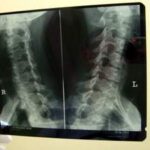It took 34-year-old Eric more than four years to get the right diagnosis. The seventh doctor he saw correctly identified his condition as Kennedy’s disease.
This rare and currently incurable condition is a neuromuscular disease also known as Spinal Bulbar Muscular Atrophy, SBMA and Kennedy’s syndrome. According to the Kennedy’s Disease Association, many patients go misdiagnosed for years or never get the right diagnosis.
One of the reasons it takes them so long to find out the source of their health problems is mistaking the disease with other neuromuscular disorders. The misdiagnosis that occurs most often is Lou Gehrig’s Disease, or ALS. However, doctors can use a DNA blood test to confirm if a patient really has Kennedy’s disease.
Causes
The National Institute of Neurological Disorders and Stroke (NINDS) reports that Kennedy’s disease is just one of a group of disorders known as spinal muscular atrophy (SMA). It’s an inherited motor neuron disease that strikes males who are typically between 20 and 40 years old. However, it can occur anywhere from the teens to the seventies.
This condition is an x-linked recessive disease. A mother carries a defective gene on one of her X chromosomes. Any daughters of a Kennedy’s disease patient are carriers, with a 50/50 chance of giving birth to a son affected by the condition. In vary rare instances, females exhibit signs of the illness. Estimates suggest that 1 out of every 40,000 individuals worldwide suffers from this disease.
Symptoms
This illness is progressive. Patients can experience many types of symptoms.
Neurological. Common signs include trouble swallowing, talking, breathing or performing other functions associated with the throat. Hand tremors also occur. Some patients have an abnormal plantar response when a health care provider scrapes the bottom of their feet. Loss of lower motor nerve function means muscle weakness and wasting. Individuals can experience neuropathy, or a loss of sensation, in some areas. When a doctor taps the patient’s knee with a hammer, it doesn’t jerk.
Muscular. It’s possible to see small muscles twitching through the skin. Some patients experience large muscle spasms or shaky muscles in certain positions. Some muscles atrophy – particularly noticeable in the legs and arms – making movement difficult or impossible. Because of cramps, calf muscles thicken.
Thoracic. A patient’s breasts become enlarged.
Endocrine. Kennedy’s disease causes a reduction in androgen levels and a loss of masculinizing effect. Patients develop an excess estrogen effect as a result.
Genito-urinary. Typical symptoms include a low sperm count, erectile dysfunction and shrinking testicles.
Others. Some patients don’t develop symptoms until in their late thirties or older. Muscles on one side of the body can be affected more severely than those on the other side. Blood tests of Kennedy’s patients show an elevated CPK enzyme. This is sometimes confused with an enzyme present during a heart attack.
Prognosis
Most patients have a near-normal lifespan. While there are no known cures of treatments for Kennedy’s disease, some patients get relief from pain and cramps with stretching exercises.
Sources:
Kennedy’s Disease Association site
National Institute of Neurological Disorders and Stroke (NINDS) site
Reference:
- Kennedy’s Disease Association site
- National Institute of Neurological Disorders and Stroke (NINDS) site



